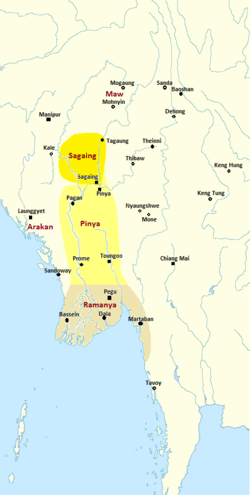Kingdom of Pinya ပင်းယခေတ် | |||||||||||
|---|---|---|---|---|---|---|---|---|---|---|---|
| 1313–1365 | |||||||||||
 Pinya Kingdom c. 1350 | |||||||||||
| Status | Kingdom | ||||||||||
| Capital | Pinya | ||||||||||
| Common languages | Burmese (official) Mon, Shan | ||||||||||
| Religion | Theravada Buddhism, Ari Buddhism, Animism | ||||||||||
| Government | Monarchy | ||||||||||
• 1313–1325 | Thihathu | ||||||||||
• 1325–1340 | Uzana I | ||||||||||
• 1344–1350 | Kyawswa I | ||||||||||
• 1359–1364 | Narathu | ||||||||||
| Regent | |||||||||||
• 1340–1344 | Sithu | ||||||||||
| Legislature | None (Rule by decree) | ||||||||||
| Historical era | Warring states | ||||||||||
• Myinsaing Regency founded | 17 December 1297 | ||||||||||
• Pinya Kingdom founded | 7 February 1313 | ||||||||||
• Sagaing secession | 1315–1317 (de facto) 1325 (de jure) | ||||||||||
| 1325–1344 | |||||||||||
• Toungoo secession | 1358–1359 | ||||||||||
• Maw raids | 1358–1364 | ||||||||||
• Ava Kingdom founded | 26 February 1365 | ||||||||||
| |||||||||||
| Today part of | Myanmar | ||||||||||
| History of Myanmar |
|---|
 |
|
|
|
|
|
|
The Kingdom of Pinya (Burmese: ပင်းယခေတ်, pronounced [pɪ́ɰ̃ja̰ kʰɪʔ]), also known as the Vijaia State (၀ိဇယတိုင်း), was the kingdom that ruled Central Myanmar (Burma) from 1313 to 1365. It was the successor state of Myinsaing, the polity that controlled much of Upper Burma between 1297 and 1313. Founded as the de jure successor state of the Pagan Empire by Thihathu, Pinya faced internal divisions from the start. The northern province of Sagaing led by Thihathu's eldest son Saw Yun successfully fought for autonomy in 1315−17, and formally seceded in 1325 after Thihathu's death.
The rump Pinya Kingdom was left embroiled in an intense rivalry between Thihathu's other sons Uzana I and Kyawswa I until 1344. Pinya had little control over its vassals; its southernmost vassals Toungoo (Taungoo) and Prome (Pyay) were practically independent. Central authority briefly returned during Kyawswa I's reign (1344−50) but broke down right after his death. In the 1350s, Kyawswa II repaired Pinya's long-strained relationship with Sagaing, in order to face off against the northern Shan state of Maw. Two Maw raids in 1358–59 and 1362–63 thoroughly devastated Pinya's countryside during which Toungoo successfully broke away. Narathu switched sides and aided the Maw attack on Sagaing in 1363–64. But after the Maw troops sacked both Sagaing and Pinya in succession in 1364, Thihathu's great grandson Thado Minbya of Sagaing seized both devastated capitals in 1364, and founded the Ava Kingdom in 1365.
Pinya was a microcosm of the small kingdoms period (1287–1555) of Burmese history. Weakened by internal divisions, Pinya despite controlling two of the three main granaries never reached its potential. Although its successor Ava would prove more successful in reassembling major parts of the erstwhile empire, it too would be hampered by fierce regional rivalries, and Myanmar would remain divided into the mid-16th century.